The holidays are over, and life has settled back into something resembling a comfortable rhythm, so it's time for: yet another batch of homebrew. This time around, it's a Kölsch-style1 ale, a light, mild, lager-like from the days before lagering - and the effective use of Saccharomyces uvarum - took hold. Cooler temperatures, lighter malts, and the right strain of yeast combine to produce a smooth brew not all that different from a good Pilsner. As the BJCP's2 Style Guide puts it:
Overall Impression: A clean, crisp, delicately balanced beer usually with very subtle fruit flavors and aromas. Subdued maltiness throughout leads to a pleasantly refreshing tang in the finish. To the untrained taster easily mistaken for a light lager, a somewhat subtle pilsner, or perhaps a blonde ale.The last time I made a batch of Kölsch, it was too dark, too malty. It was a fine beer, but not quite right, stylistically. So I had to give it another shot.
History: Kölsch is an appellation protected by the Kölsch Konvention, and is restricted to the 20 or so breweries in and around Cologne (Köln). The Konvention simply defines the beer as a “light, highly attenuated, hop-accentuated, clear top-fermenting Vollbier.”
So here - featuring a test run of photos from my new camera - is the homebrew process:3
- Gather the necessary ingredients.
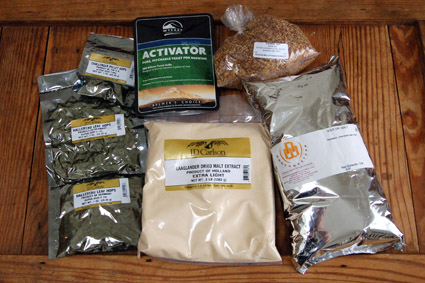
- Malt extract - 3 lbs. extra-pale dried extract, 2 lbs. pale dried extract. This is the bulk of the beer, in the form of dried, powdered malt sugars. Hopefully this combination will result in a light, golden beer.
- Crystal malt (20L)4 - 1 lb. To give the beer more body, or mouthfeel. Crystal malts, which are full of sugars that yeast can't digest, lend certain flavors - caramel, toffee, etc. - with the soluble but nonfermentable sugar makeup. Those extra molecule floating about in the beer counteract the thinness that would occur with just malt extract.
- Hops - 0.75 oz. Challenger pellet hops, 2 oz. Hallertau leaf hops. The Challenger hops are to give the beer its backbone of bitterness, while the Hallertau will, in two separate additions, give some bitterness and their own distinct aroma. Hallertau is a noble hop variety from Germany, and so ought to be about right for a German brew.
- Yeast - 1 "smack pack" of Wyeast 2565 Kölsch. Although the malts used will give the overall base flavor to a beer, the yeast is what primarily sets the flavor profile and generates most of the aroma.
- Malt extract - 3 lbs. extra-pale dried extract, 2 lbs. pale dried extract. This is the bulk of the beer, in the form of dried, powdered malt sugars. Hopefully this combination will result in a light, golden beer.
- Steep the grains. Boiling crystal malts imparts a wealth of harsh flavors into the beer, including tannins leached from the grain husks. To get around this, the cracked grains steep in a gallon of hot - approximately 156°F - water for twenty minutes. The grains are then discarded, and the remaining liquid added to the brew kettle.
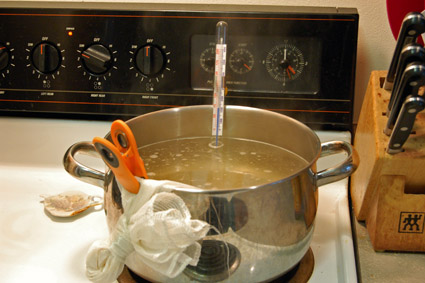
- Dissolve the malt extract in the brew kettle. The more wort that can be boiled at once, the better, because higher concentrations of malt complicate the brewing process. My stove can handle five gallons at once, but I get a better - and quicker - boil with four gallons, which makes things much easier. Hop extraction is still pretty good, and I'm able to keep a gallon or more of cool or cold sanitized water for reducing the wort temperature and diluting afterwards.
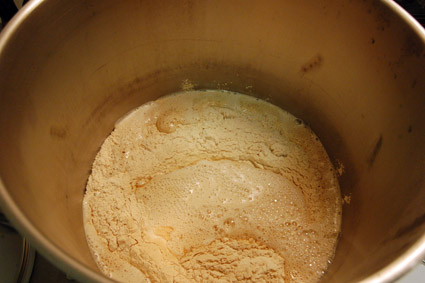
- Boil the wort. This takes at least an hour, sometimes more in the case of high-gravity beers or certain styles. I added the Challenger hops - for bittering - at the start of the boil. Longer boiling times convert more of the hops' alpha acid to bitterness, and drive off more aroma.
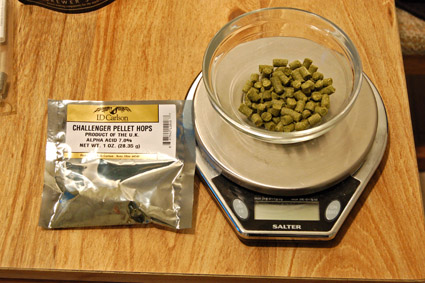
- Sanitize the fermentor. Sterilization's too difficult to achieve, especially in a home kitchen. Instead, the goal is to sanitize the equipment - anything that will come in contact with the wort after it's cooled from the boil - so that the yeast can take over before any other microorganisms do. I use an oxygen-based cleanser, rather than bleach, because it's more forgiving if it's not rinsed well enough, and it's probably much more environmentally friendly.
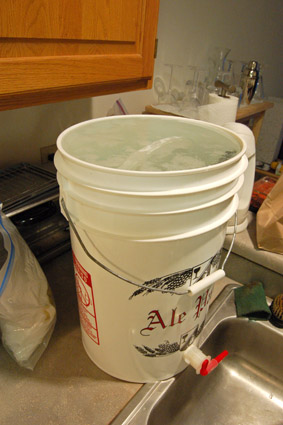
- Add the wort chiller. Since a big coil of copper tubing wouldn't respond terribly well to sanitizing chemicals - and wouldn't be terribly fun to fight with, either - it simply gets added to the boiling wort for the last fifteen or twenty minutes. Around this time, I've also added in the second batch of hops, an ounce of the Hallertau. With twenty minutes, it'll lend both some bitterness and some hop flavor.
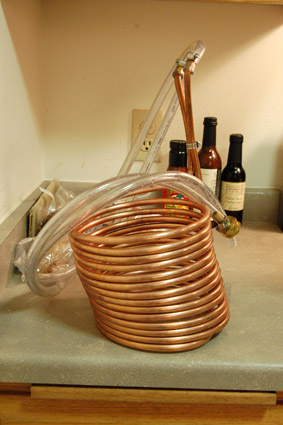
- Add some seaweed. It's called Irish Moss, or sometimes carageenan, and it's a seaweed that grows in rocky shorelines on both sides of the northern Atlantic. It also has a strong ionic charge, which helps attract haze-causing proteins that might otherwise produce a cloudy beer. It all settles to the bottom, to be filtered out of the beer later. The leaf hops - as opposed to the pellets - also help eliminate haze by acting as floating filters.

- Add the aroma hops. With just five minutes left in the boil, it's time to add the last of the Hallertau hops, which will give their aroma, but virtually no bitterness, to the final beer.
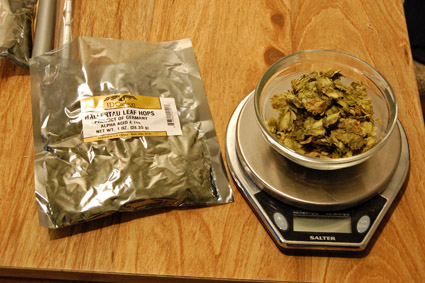
- Cool the wort. Quickly. This is where the wort chiller comes in handy. Connected to a cold tap, it pumps cool water through the wort, extracting heat far more efficiently than a cold water bath would. At this point, the hot wort is very sensitive to oxidation, which can result in charming flavors, such as wet cardboard. The longer it takes to cool - so it's at a safe temperature to add the yeast - the more of a worry that becomes. A wort chiller cools down four or five gallons from a boil to room temperature in fifteen to twenty minutes.
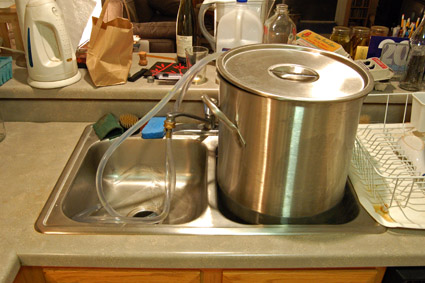
- Test the specific gravity. Measuring the specific gravity of the wort gives a very good approximation of the amount of fermentable sugars and the potential alcohol level of the beer. The tool is a hydrometer, a calibrated glass cylinder of a specific density. The OG here is about 1.047, meaning that the final beer will be somewhere near 4.5% alcohol.
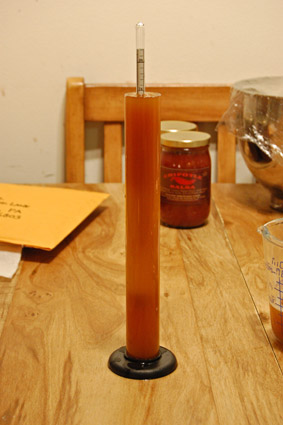
- Pitch the yeast. After filtering out the hops and aerating the wort, the yeast goes in. Closed tightly, but for an airlock to let out the massive amounts of carbon dioxide they yeast will produce during fermentation, it's time to wait and see what happens.
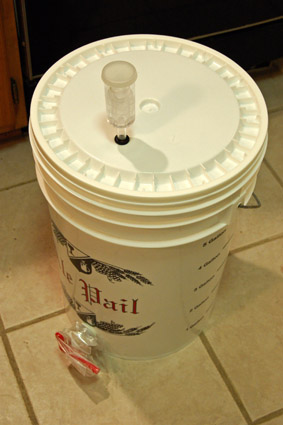
* * * * *
1"Kölsch-style" because you can only get real Kölsch in Köln. That said, when I get around to devising a label, it'll probably skip over that distinction.
2Beer Judge Certification Program.
3For extract-based brewing. I don't currently have an all-grain brewing system set up, mostly due to space limitations.
4The 'L' refers to the Lovibond scale, which refers to how dark the malt roast is, and roughly corresponds to how heavily roasted it is. (Also sometimes used is the SRM, or Standard Research Method, scale.) Higher numbers mean darker, with the palest malts at 1 - 2L, up to 450L for a dark chocolate malt; these various different roast levels carry different flavors.
